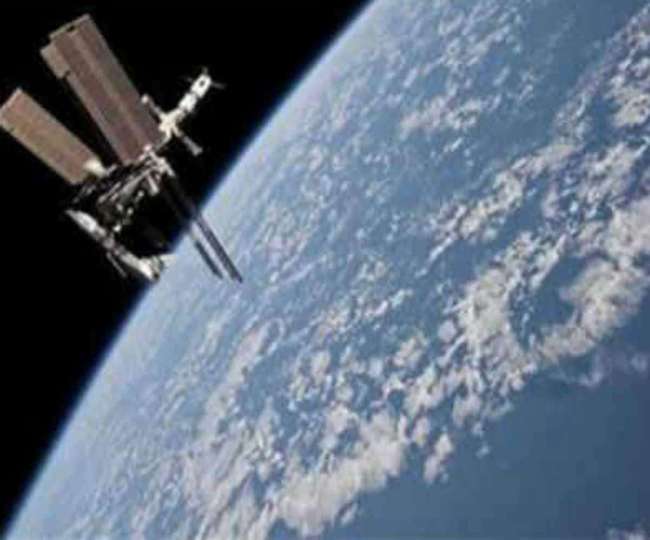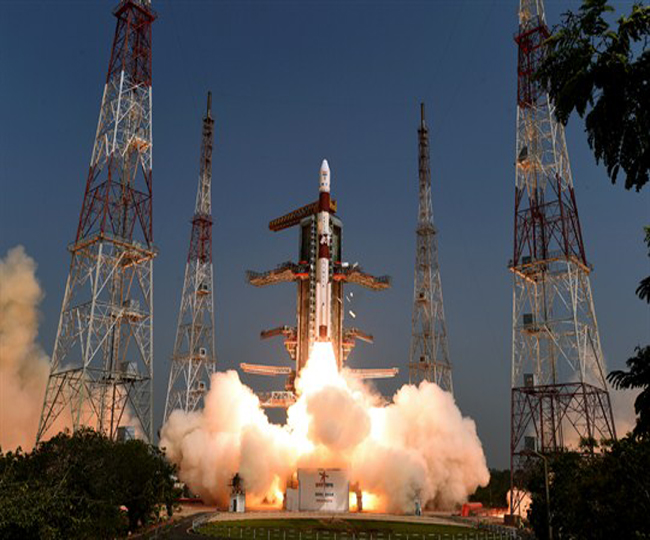News Clipping on 17-04-2019

WASHINGTON, APRIL 16, 2019 21:28 IST
Private forecaster Skymet predicts ‘below normal’ Monsoon

हाइलाइट्स
- वित्त मंत्री के अनुसार, पाकिस्तान और IMF के बीच बेलआउट पैकेज को लेकर सहमति बन गई है
- वित्तीय संकट से गुजर रहे पाकिस्तान को 15 बिलियन डॉलर की मदद की जरूरत है
- पाक वित्त मंत्री ने बताया कि वर्ल्ड बैंक से 7-8 बिलियन डॉलर की मदद मिलेगी
- वित्त मंत्री के अनुसार 6 से 8 बिलियन डॉलर आईएमएफ और एडीबी से मदद मिल सकती है
गंभीर वित्तीय संकट से गुजर रहे पाकिस्तान की अर्थव्यवस्था को पटरी पर लाने के लिए इमरान खान सरकार की बड़ी बाधा दूर हो गई है। पाकिस्तान और अंतरराष्ट्रीय मुद्रा कोष ने बेलआउट पैकेज के लिए दस्तावेज पूरे कर उन पर हस्ताक्षर कर लिए हैं। पाकिस्तान के अखबार द डॉन में पाक वित्त मंत्री असद उमर के हवाले से लिखा गया है कि बेलआउट पैकेज के तहत एक्सचेंज रेट, पब्लिक फाइनैंस, राजकीय घाटा और ऊर्जा की कीमतों पर सहमति बन गई है।
वित्त मंत्री का कहना है कि आईएमएफ टीम अप्रैल के तीसरे सप्ताह में तकनीकी पक्षों पर गौर करने के लिए इस्लामाबाद का दौरा करेगी। मंत्री के हवाले से रिपोर्ट में कहा गया है कि आईएमएफ डील में कुछ देरी हो सकती है क्योंकि बैंक अधिकारी इस्लामाबाद का दौरा मई में ही कर पाएंगे।
पाकिस्तान को 15 बिलियन डॉलर मदद की है जरूरत
फंड प्रोग्राम के तहत कितनी मदद मिलेगी इसे लेकर अभी कुछ पुष्टि नहीं की गई है, लेकिन मिली जानकारी के अनुसार यह 6 बिलियन से 8 बिलियन तक हो सकता है। वर्ल्ड बैंक और एशियन डिवेलपमेंट बैंक भी इस्लामाबाद को संकट से उबारने के लिए मदद करेंगे। अर्थव्यवस्था को पटरी पर लाने के लिए पाकिस्तान को करीब 15 बिलियन डॉलर की जरूरत है। पाक वित्त मंत्री ने बताया कि वर्ल्ड बैंक से 7-8 बिलियन डॉलर की मदद मिलेगी और 6 से 8 बिलियन डॉलर आईएमएफ और एडीबी से मदद मिल सकती है। पाकिस्तान इंटरनैशनल बॉन्ड के जरिए भी पैसे जुटाने की कोशिश कर रहा है।
FATF रिपोर्ट से भारत की बढ़ सकती है चिंता
पाकिस्तान को मिल रही वित्तीय मदद नहीं एफएटीएफ रिपोर्ट भारत की फिक्र बढ़ाने के लिए काफी है। पाक वित्त मंत्री ने एक बयान में कहा, ‘पाकिस्तान ने फाइनैंशल ऐक्शन टास्क फोर्स (एफएटीएफ) के पास अपनी फाइनल रिपोर्ट भेज दी है।’ एफएटीएफ पैरिस स्थित वह संस्था है जो मनी लॉन्ड्रिंग और आतंकवाद की फंडिंग को रोकने के लिए काम करती है। पाक मंत्री ने बताया कि पाकिस्तान आकर मौजूदा हालात की समीक्षा के लिए एफएटीएफ टीम मई में आएगी।
करंसी मजबूत करने के लिए पाक ने उठाए सकारात्मक कदम
पिछले साल पाकिस्तान को एफएटीएफ ने ग्रे लिस्ट में रखा था- आधिकारिक तौर पर इसे ‘हाई रिस्क और इसके अधिकार क्षेत्र में’ आनेवाले आतंकी संगठनों की फाइनैंस को रोकने में नाकाम रहने के कारण ग्रे लिस्ट में रखा गया था। एफएटीएफ की 22 फरवरी 2019 की हालिया रिपोर्ट के अनुसार, ‘पाकिस्तान ने अपने AML/CFT के स्तर को सुधारने के लिए कई उल्लेखनीय कदम उठाए हैं। साथ ही करंसी को मजबूत करने के लिए भी कुछ ठोस कदम उठाए हैं।’ रिपोर्ट में हालांकि स्पष्ट कहा गया है, ‘अभी तक कोई भी ठोस और निर्णायक कदम टेररिज्म फाइनैंस को रोकने के लिए नहीं उठाया गया है। आतंकी संस्थाओं अलकायदा, जमात-उद-दावा, लश्कर-ए-तैयबा और तालिबान से जुड़े आतंकी संगठनों को फाइनैंस करने के खतरों को समझकर उसे रोकने के लिए पर्याप्त समझदारी नहीं देखने मिली।’ मसूद अजहर को वैश्विक आतंकी घोषित करने के लिए भारत ने एफएटीएफ के जरिए भी अपनी सक्रियता दिखाई थी।

क्या भारत-चीन के बीच शुरू हो सकता है स्पेश वार
 भारत के उपग्रह रोधी मिसाइल के परीक्षण से नई दिल्ली और बीजिंग के बीच स्पेश वार की शुरुआत हो सकती है।
भारत के उपग्रह रोधी मिसाइल के परीक्षण से नई दिल्ली और बीजिंग के बीच स्पेश वार की शुरुआत हो सकती है।
वाशिंगटन, पीटीआइ। अमेरिकी विशेषज्ञों का दावा है कि भारत के उपग्रह रोधी मिसाइल (ASAT) के परीक्षण से नई दिल्ली और बीजिंग के बीच स्पेश वार की शुरुआत हो सकती है। विशेषज्ञों ने यह आशंका जाहिर किया है कि दोनों देशों के बीच स्पेश में प्रतिद्वंद्विता का दौर शुरू हो सकता है। बता दें कि भारत ने पिछले महीने एक उपग्रह रोधी मिसाइल का परीक्षण किया था। अमेरिकी विशेषज्ञों का कहना है कि भारत ने यह परीक्षण बीजिंग को लक्षित करके किया है। एशले जे टेलिस, स्ट्रैटेजिक अफेयर्स के लिए टाटा चेयर और कार्नेजी एडॉमेंट फार इंटरनेशनल पीस के वरिष्ठ साथी ने मंगलवार को कहा कि भारत का ASAT परीक्षण एक तरह से चीन के लिए ही था। भारत को अंतरिक्ष प्रतियोगिता के लिए अब तैयार रहना होगा।
हालांकि, इस परीक्षण के बाद भारत ने दुनिया के समक्ष अपने रुख को साफ करते हुए कहा था हम एक लोकतांत्रिक देश है और अपनी जिम्मेदारियों को भलीभांति समझते हैं। भारत का कहना है कि उसके समस्त प्रयास आत्मरक्षा और विकास के लिए है। भारत के इस परीक्षण से किसी भी देश को आपत्ति नहीं होनी चाहिए।

बता दें कि 27 मार्च को भारत ने अपने ही एक उपग्रह को उसकी कक्षा में अंतरिक्ष मिसाइल से नष्ट कर दिया था। इसके सफल परीक्षण के साथ ही यह तकनीक विकसित करने वाला भारत दुनिया का चौथा मुल्क बन गया है। इसके पहले यह क्षमता अमेरिका, रूस और चीन के पास थी। विशेषज्ञों का दावा है कि निश्चित रूप से चीन ने अमेरिका के जवाब में अपनी स्पेश क्षमताओं काे विकसित किया है। लेकिन नई दिल्ली को अब इस चीनी कार्यक्रम से खतरा उत्पन्न हो गया है। उन्होंने कहा कि भारत को बढ़ते चीनी खतरों के बावजूद अंतरिक्ष के उपयोग करने की अपनी क्षमता में सुधार करना चाहिए। इसके साथ ही अंतरिक्ष की सुरक्षा और नागरिक उपयोग की प्रतिबद्धता को बनाए रखना होगा।
Posted By: Ramesh Mishra
कीमोथेरेपी, लंग कैंसर के लिए नया प्रयोग
Publish Date:Wed, 17 Apr 2019 01:45 PM (IST)

नई दिल्ली [जागरण स्पेशल]। फेफड़े के कैंसर के इलाज के लिए वैज्ञानिक टार्गेटेड कीमोथेरेपी को लेकर नया प्रयोग कर रहे हैं। वैज्ञानिकों की तैयारी है कि इंजेक्शन या दवा के रूप में देने के बजाय सांस के रास्ते कीमोथेरेपी दी जाए। ऑस्ट्रेलिया की क्वींसलैंड यूनिवर्सिटी ऑफ टेक्नोलॉजी के वैज्ञानिक नजरुल इस्लाम ने बताया कि फेफड़े का कैंसर सबसे ज्यादा होने वाले और सर्वाधिक जानलेवा कैंसर में शुमार है।
इस्लाम ने कहा, ‘हम इनहेलर के जरिये चिटोसन के नैनोपार्टिकल की मदद से दवा को सांस के रास्ते सीधे फेफड़े तक पहुंचाने की दिशा में कार्य कर रहे हैं।’ चिटोसन एक प्राकृतिक पॉलीमर है, जो अपने आप विघटित हो जाता है। इसके साथ दवाओं को आसानी से जोड़ा जा सकता है। वैज्ञानिक चिटोसन का ऐसा प्रकार खोज रहे हैं, जो फेफड़े के विशेष ऊतकों (टिश्यू) तक पहुंचकर पूरी तरह विघटित हो जाए और उसके साथ भेजी गई दवा अपना काम कर सके।

जानें क्या है कीमोथेरेपी
कीमोथेरेपी ड्रग्स वो दवाएं हैं जिनका प्रयोग कैंसर के सेल्स को खत्म करने के लिये किया जाता है, इनसे ट्यूमर सिकुड़ जाते हैं और कैंसर फैलने भी नहीं पाता है। सामान्यत: सभी ड्रग्स कैंसर के सेल्स को खत्म करने का काम करते हैं या कैंसर के सेल्स को बढ़ने से रोकते है। कैंसर के सेल्स को खत्म करने के लिए कीमोथेरेपी भी एक अच्छा तरीका है। कीमोथेरेपी कैंसर के सेल्स को शरीर के दूसरे भाग में नहीं फैलने देता जैसे कि हड्डियों में, लीवर में या दिमाग में।
कीमोथेरेपी के साइडइफेक्ट्स
कैंसर जानलेवा बीमारी है, कीमोथेरेपी से उन खतरनाक सेल्स को काबू में किया जाता है। लेकिन कीमोथेरेपी के दौरान प्रयोग की जाने वाली दवाओं अतिरिक्त प्रभाव भी हो सकते हैं। इनमें से सामान्य है थकान, नींद नआना, लगातार उल्टियां होना, दस्त, मुंह में घाव होना, बालों का झड़ना, त्वचा पर चकत्ते, खून की कमी होना, आदि। इसके कारण ब्लड में इंफेक्शन और खून का बहाव भी हो सकता है। दूसरे अतिरिक्त प्रभाव जैसे एलर्जिक क्रिया, स्तब्ध हो जाना, हाथों और पैरों में झुनझुनी होना, ब्लैडर से खून का आना।

गर्भावस्था के दौरान इन दवाओं का प्रयोग बिलकुल नहीं करना चाहिए, इससे गर्भ को भी परेशानी हो सकती है। कुछ प्रकार की कीमोथेरेपी ड्रग्स से इन्फर्टिलिटी भी हो सकती है। अगर आप आने वाले सालों में बच्चा चाहते हैं तो कीमोथेरेपी से पहले चिकित्सक की सलाह लें। एक तरफ जहां कीमोथेरेपी कैंसर कोशिकाओं को खत्म करने के लिए रोगियों को दी जाती है वहीं इससे शरीर की प्रतिरोधक क्षमता कमजोर होने का खतरा भी बना रहता है। साथ ही इससे इससे वजन कम हो जाता है व रक्त में हीमोग्लोबिन की मात्रा व प्लेटलेट्स की संख्या भी घट जाती है।
कीमोथेरेपी साइडइफेक्ट्स का उपचार
कीमोथेरेपी के साइड-इफेक्ट पर नियंत्रण पाने में सबसे अधिक योगदान खानपान का होता है। यदि आपको कीमोथेरेपी के कारण मतली या उल्टी की शिकायत है तो खाने में तला-भुना, ज्यादा मसालेदार, अधिक नमक युक्त आदि खाने से परहेज करना चाहिए। इसकी जगह पर संतुलित और आसानी से पचने वाला आहार लेना चाहिए।

नियमित व्यायाम को अपने जीवन में शामिल कीजिए, सुबह के समय 40 से 50 मिनट व्यायाम, योग और मेडीटेशन के लिए दीजिए। चूंकि इस समय बालों के गिरने की समस्या भी होती है ऐसे में बालों में ड्रायर का प्रयोग न करें, हेयर डाई न लगायें। इसके अलावा धूम्रपान और शराब का सेवन बिलकुल न करें, अधिक मात्रा में कैफीन का सेवन भी न करें। कीमोथेरेपी बहुत ही दर्दनाक प्रक्रिया होती है, इससे उबरने के बाद यदि आपको इसके साइड-इफेक्ट से जूझने पर भी हिम्मत से काम लें। हमेशा चिकित्सक के संपर्क में भी रहें।
Posted By: Sanjay Pokhriyal


